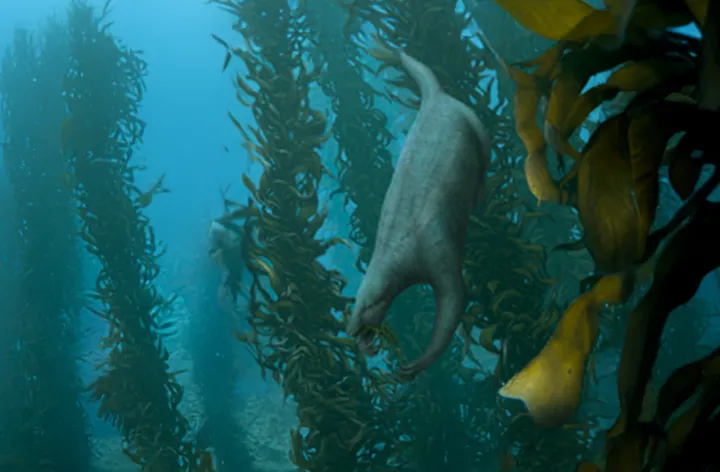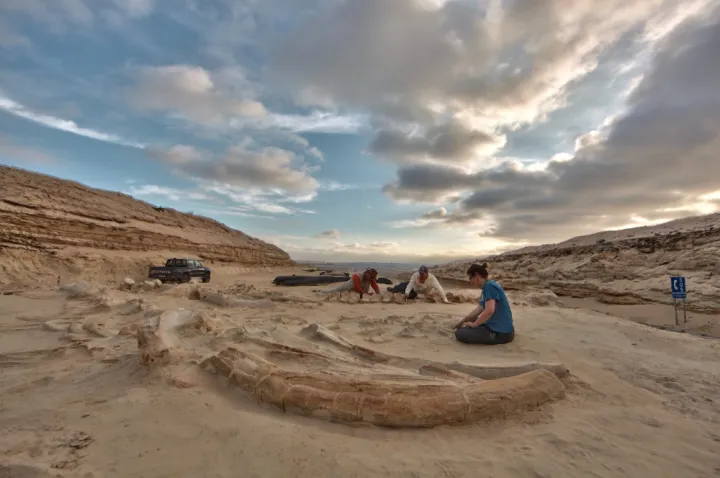The Sloths that Once Swam in the Sea

In the sands of the Atacama Desert in Chile, scientists unearthed what could be considered by some to be a peculiar find—a sloth skeleton among the remnants of an ancient seabed. For paleontologists, the clues in the rocks and sand point to an evolving world, where ancient seafloors have been uplifted into the desert and sea levels have changed, leaving behind sharks, plankton, and sea snails. Among those ocean remnants is an aquatic sloth.
Known for their glacial pace and shy personality, today’s sloths are beloved mammals found among the canopies of lush forests and jungles. Travel back in time to the Miocene era along the coast of what is now Chile and Peru, and their distant cousins lived a much different life. Along the shores of ancient seas, giant sloths took to the meadows of the coast where they grazed on lush seagrass and algae. Equipped with special adaptations, they were right at home swimming and diving among the waves.
Like today’s sea cows, aquatic sloths were the grazers of the coastal ecosystem, maintaining the seagrass beds like lawn mowers in the suburbs. Evidence from their fossilized bones show that over geologic time, an entire lineage of ancient sloths adapted to a marine lifestyle by evolving dense bones to stay submerged, strengthened hands to grip the seafloor bottom, and a seal-like nose with nostrils on top of their snout instead of in front.
Since aquatic sloths are now extinct, scientists turn to clues hidden in the fossil record to better understand the life and habits of a sloth living in the sea. The recently unearthed fossilized sloth skeletons in the Atacama Desert added a mostly complete skeleton to the very small collection of excavated aquatic sloth fossils. This specimen of Thalassocnus natans is among one of five known species of aquatic sloth that lived from between 9.2 million years ago (mya) to 4.8 mya.
In 1995, the first aquatic sloth skeleton was found in Peru. It was discovered among other coastal dwellers like fish and crocodiles. Soon after smaller skeletal fragments appeared in Chile as well. The addition of the recently unearthed T. natans specimen is the most complete skeleton from the region and slight differences in the skeleton indicate that there may have been variation within the species. Often in the animal kingdom, females and males are visibly different from one another. The same is the case for adolescent individuals and fully grown adults. With so few unearthed skeletal remains, it is difficult to determine whether slight differences are due to variation or different species.
What we do know about aquatic sloths comes from clues in their bones. The earliest of these specimens, including T. natans, T. littoralis, and T. antiquus, showed early signs of life at sea. The Atacama has been a desert since before sloths evolved, in a time period known as the Cretaceous. Recent evidence suggests that the desert experienced a greening during the Late Miocene, around the time the first sloths turned to the sea in search of food. In particular, grooves in their teeth indicate that as the sloths chewed their food, sand grit wore away their teeth. Scientists believe that these sloths scavenged seagrass and seaweed that washed ashore and that the sloths stayed close to the coast rather than wading further into the deep. Their skull anatomy also indicates strong lips, which likely were used to graze on shallow sea grasses. The younger species, T. carolomartini, and T. yaucensis, show the progression of adaptations for a life more suited for marine living. Denser and thicker bones made it easier to stay submerged and dive, and evidence of sand grinding disappeared from fossilized teeth, indicating they were no longer chewing along beaches. T. yaucensis, the most recent species, also had a downward facing head, which likely helped it graze along the seafloor from above. Its tail was likely used for steering and balance, rather than for propulsion like in whales.
What is becoming clearer is that aquatic sloths were an important part of the coastal ecosystem along the ancient South Pacific Ocean, filling a role similar to the sea cows and Desmostylia, a group of ancient hippo-like mammals known from fossils found along the coasts of Japan, Canada, the US and Mexico. In the North Pacific, Desmostylia and sea cows were the primary herbivorous mammals in coastal waters, and their foraging kept kelp forests and seagrass beds in check. Without any other large coastal mammals in the South Pacific, this role was mainly carried out by the sloths. Though, while North Pacific grazers grew to massive sizes—the recently extinct Steller’s sea cow reached sizes of 33 feet long and between 5.5–11 tons (11,000–22,000 lbs) — aquatic sloths only grew to be between 7 and 11 feet long. Scientists think this has to do with the types of seaweed available in each region, with dense kelp forests filled with a seaweed understory in the north, and more sparse brown algae beds in the south. Regardless of relative size, the fact that sloths were once marine dwellers diving among the seagrass beds remains an amazing example of how life evolves in the most amazing ways.



